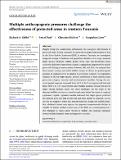Multiple anthropogenic pressures challenge the effectiveness of protected areas in western Tanzania

View/
Date
2022-03-29Author
Giliba, Richard
Fust, Pascal
Kiffner, Christian
Loos, Jacqueline
Metadata
Show full item recordAbstract
Despite being key conservation instruments, the ecological effectiveness of protected areas (PAs) is contested. To assess the ecological effectiveness of PAs in the Katavi-Rukwa Ecosystem (KRE) in western Tanzania, we investigated temporal changes in land-use and population densities of six large mammal target species (elephant, buffalo, giraffe, zebra, topi, and hartebeest) across areas with different conservation category, ranging from unprotected to strictly protected. During six survey periods between 1991 and 2018, we analyzed data from remote sensing and aerial wildlife surveys to derive (i) spatiotemporal patterns of cropland cover in relation to protection category; (ii) population densities of the six-target species; and (iii) distribution of these species across protection category, land-use and environmental variables. During the surveyed period, cropland increased from 3.4 % to 9.6 % on unprotected land and from ≤0.05 % to <1 % on protected land. Wildlife densities of most, but not all target species declined across the entire landscape, yet the onset of the observed wildlife declines occurred several years before the onset of cropland expansion. Logistic regression models indicated that target species preferred the national park over less strictly PAs and areas distant to cropland. As our data do not support a direct link between land-use change and wildlife densities, additional factors may explain the apparent ecosystem-wide decline in wildlife. To bolster wildlife conservation in the KRE, we recommended proactive strategies to reduce direct threats to wildlife and cropland expansion toward wildlife dispersal areas and migratory corridors.
